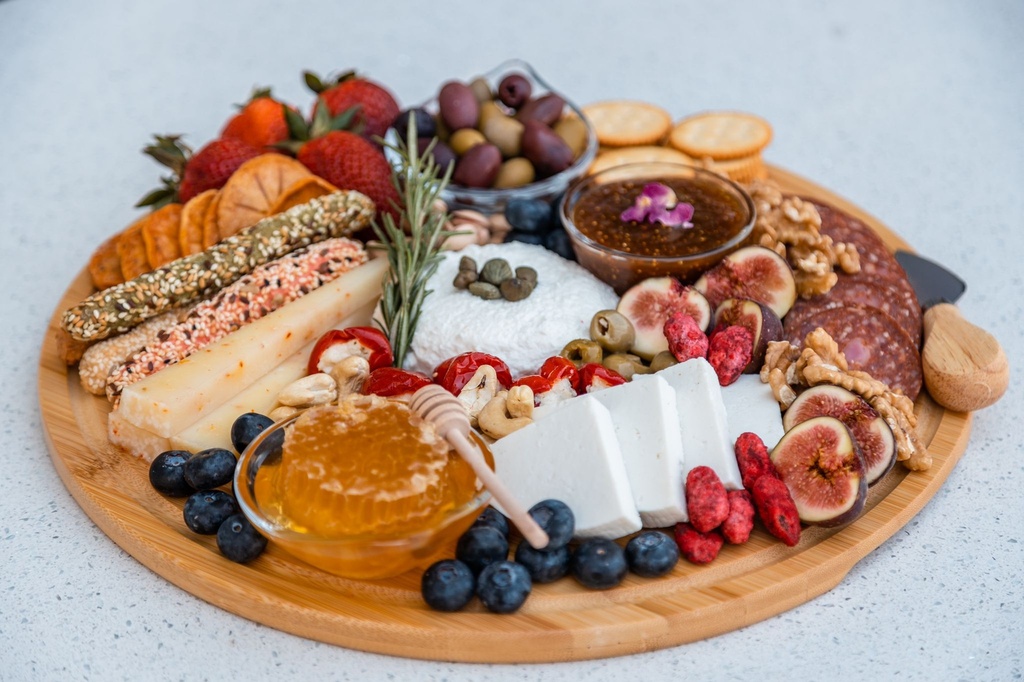There’s something inherently elegant and satisfying about a well-crafted cheese board. Whether you’re hosting a formal dinner party, a casual gathering of friends, or simply indulging in a quiet evening at home, a cheese board can transform your dining experience into a memorable and delightful affair. In this blog, we’ll explore the art of creating the perfect cheese board, from selecting the finest cheeses to pairing them with complementary accompaniments and presenting it all in a visually stunning manner.
Selecting Your Cheeses
The foundation of any cheese board is, of course, the cheeses themselves. When choosing your cheeses, aim for a variety of textures, flavors, and milk sources. A well-rounded cheese board typically includes the following categories:
- Hard Cheese: Examples include Cheddar, Gouda, or Manchego. These cheeses are firm, often aged, and provide a nice contrast to other textures on the board.
- Soft Cheese: Brie, Camembert, or goat cheese fall into this category. Soft cheeses are creamy and spreadable, offering a rich and velvety texture.
- Blue Cheese: Roquefort, Stilton, or Gorgonzola are classic choices. Blue cheeses provide a pungent and bold flavor, adding complexity to the board.
- Semi-Soft Cheese: Consider options like Havarti, Fontina, or Port Salut. These cheeses are pliable, slightly creamy, and pair wonderfully with various accompaniments.
- Fresh Cheese: Include fresh mozzarella, feta, or ricotta for a refreshing, mild element on the board.
Pairing Perfection
The right cheese pairings can elevate your board to new heights. Here are some accompaniments to consider:
- Bread and Crackers: Sliced baguette, crispy crackers, and breadsticks provide a sturdy base for your cheese and add textural contrast.
- Fruits: Fresh or dried fruits like grapes, figs, apples, and pears add natural sweetness and a refreshing element.
- Nuts: Almonds, walnuts, and pecans add crunch and a nutty dimension to your board.
- Charcuterie: Cured meats like prosciutto, salami, or chorizo can provide a savory and salty balance to the cheeses.
- Condiments: Offer a variety of spreads like honey, chutney, and grainy mustard to enhance the flavors of the cheeses.
- Pickles and Olives: Briny options like gherkins and Kalamata olives provide a tangy contrast to the richness of the cheese.
Presentation Matters
Creating an eye-catching cheese board is just as important as selecting the right ingredients. Here are some tips for an aesthetically pleasing presentation:
- Balance and Symmetry: Distribute cheeses and accompaniments evenly, ensuring a sense of balance and symmetry on the board.
- Variety of Colors and Textures: Incorporate colorful ingredients to make the board visually appealing. This can be achieved through a variety of cheeses, fruits, and charcuterie.
- Use Wooden Boards or Platters: Wooden serving boards or marble slabs provide a rustic and elegant backdrop for your cheese selection.
- Garnish: Add a few sprigs of fresh herbs or edible flowers for a touch of freshness and a pop of color.
- Label the Cheeses: Small labels or chalkboard signs can be used to identify each cheese, helping guests navigate the board.
Conclusion
A well-crafted cheese board is a true work of art. It’s a delightful way to explore the diverse world of cheese and its endless possibilities for pairings. By selecting a variety of cheeses, complementary accompaniments, and presenting them with care, you can create a cheese board that not only tantalizes the taste buds but also delights the eyes. So, whether you’re entertaining guests or enjoying a cozy evening in, a cheese board is a versatile culinary masterpiece that will leave a lasting impression. So, go ahead, experiment, and create your own masterpiece to savor and share with those you love.



